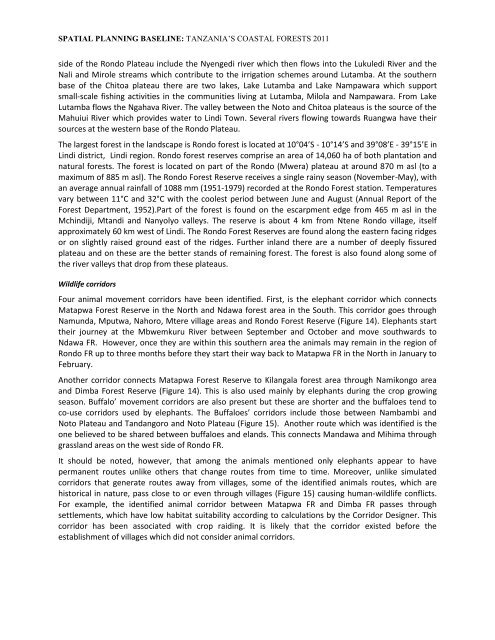Neil D. Burgess, Paul Harrison, Peter Sumbi, James Laizer, Adam ...
Neil D. Burgess, Paul Harrison, Peter Sumbi, James Laizer, Adam ...
Neil D. Burgess, Paul Harrison, Peter Sumbi, James Laizer, Adam ...
Create successful ePaper yourself
Turn your PDF publications into a flip-book with our unique Google optimized e-Paper software.
SPATIAL PLANNING BASELINE: TANZANIA’S COASTAL FORESTS 2011<br />
side of the Rondo Plateau include the Nyengedi river which then flows into the Lukuledi River and the<br />
Nali and Mirole streams which contribute to the irrigation schemes around Lutamba. At the southern<br />
base of the Chitoa plateau there are two lakes, Lake Lutamba and Lake Nampawara which support<br />
small-scale fishing activities in the communities living at Lutamba, Milola and Nampawara. From Lake<br />
Lutamba flows the Ngahava River. The valley between the Noto and Chitoa plateaus is the source of the<br />
Mahuiui River which provides water to Lindi Town. Several rivers flowing towards Ruangwa have their<br />
sources at the western base of the Rondo Plateau.<br />
The largest forest in the landscape is Rondo forest is located at 10°04’S - 10°14’S and 39°08’E - 39°15’E in<br />
Lindi district, Lindi region. Rondo forest reserves comprise an area of 14,060 ha of both plantation and<br />
natural forests. The forest is located on part of the Rondo (Mwera) plateau at around 870 m asl (to a<br />
maximum of 885 m asl). The Rondo Forest Reserve receives a single rainy season (November-May), with<br />
an average annual rainfall of 1088 mm (1951-1979) recorded at the Rondo Forest station. Temperatures<br />
vary between 11°C and 32°C with the coolest period between June and August (Annual Report of the<br />
Forest Department, 1952).Part of the forest is found on the escarpment edge from 465 m asl in the<br />
Mchindiji, Mtandi and Nanyolyo valleys. The reserve is about 4 km from Ntene Rondo village, itself<br />
approximately 60 km west of Lindi. The Rondo Forest Reserves are found along the eastern facing ridges<br />
or on slightly raised ground east of the ridges. Further inland there are a number of deeply fissured<br />
plateau and on these are the better stands of remaining forest. The forest is also found along some of<br />
the river valleys that drop from these plateaus.<br />
Wildlife corridors<br />
Four animal movement corridors have been identified. First, is the elephant corridor which connects<br />
Matapwa Forest Reserve in the North and Ndawa forest area in the South. This corridor goes through<br />
Namunda, Mputwa, Nahoro, Mtere village areas and Rondo Forest Reserve (Figure 14). Elephants start<br />
their journey at the Mbwemkuru River between September and October and move southwards to<br />
Ndawa FR. However, once they are within this southern area the animals may remain in the region of<br />
Rondo FR up to three months before they start their way back to Matapwa FR in the North in January to<br />
February.<br />
Another corridor connects Matapwa Forest Reserve to Kilangala forest area through Namikongo area<br />
and Dimba Forest Reserve (Figure 14). This is also used mainly by elephants during the crop growing<br />
season. Buffalo’ movement corridors are also present but these are shorter and the buffaloes tend to<br />
co-use corridors used by elephants. The Buffaloes’ corridors include those between Nambambi and<br />
Noto Plateau and Tandangoro and Noto Plateau (Figure 15). Another route which was identified is the<br />
one believed to be shared between buffaloes and elands. This connects Mandawa and Mihima through<br />
grassland areas on the west side of Rondo FR.<br />
It should be noted, however, that among the animals mentioned only elephants appear to have<br />
permanent routes unlike others that change routes from time to time. Moreover, unlike simulated<br />
corridors that generate routes away from villages, some of the identified animals routes, which are<br />
historical in nature, pass close to or even through villages (Figure 15) causing human-wildlife conflicts.<br />
For example, the identified animal corridor between Matapwa FR and Dimba FR passes through<br />
settlements, which have low habitat suitability according to calculations by the Corridor Designer. This<br />
corridor has been associated with crop raiding. It is likely that the corridor existed before the<br />
establishment of villages which did not consider animal corridors.

















